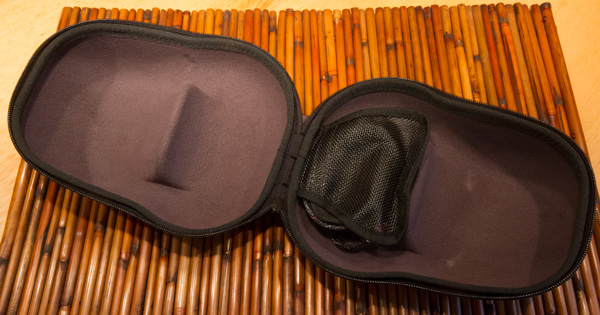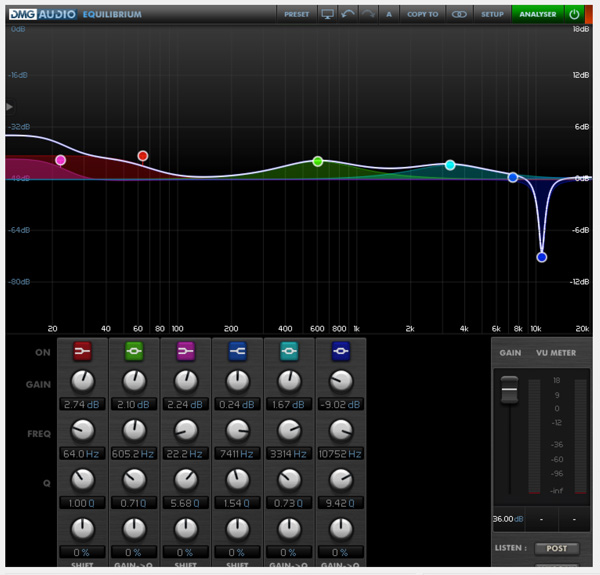| Columns Retired Columns & Blogs |
Cool and Confident: Mr. Speakers Ether Planar Magnetic Headphones Page 2

More than any other category, hard-core headphone enthusiasts love to rage about the failings of top-of-the-line headphones. It's perfectly understandable. When a $1500 headphone doesn't crush the performance of a much lower priced headphone—let's say the $400 Sennheiser HD 600 or $300 HiFiMAN HE400S—most enthusiasts are want to winge about it. But that's life. Developing headphones at this level is an expensive proposition, and normal diminishing return curves, it's quite understandable in this new but increasingly maturing category that manufacturers aren't hitting "perfection" yet...as if there were such a thing.
So, for the purposes of this review, I'll briefly describe the Ether's sonic characteristics as I heard it, and then compare them to a few other well known headphones in this rarified field.
Having spent some time with Bob Katz EQing headphones I decided to replicate his set-up on my MacBookPro and purchased a copy of JRiver's Media Center and DMG Audio's parametric equalizer plug-in called EQuilibrium. Oh boy, what a fun toy. Previously I hadn't focused on EQing headphones as I really can't review them post-EQ. What I've found (and shame on me for not figuring this out long ago) is that using pink noise and the parametric equalizer I'm able to much more readily subjectively identify exactly where headphones have emphasized or reduced frequency response. My experience with the tool has shown me that the measured performance provides a good starting point and hints at where problems lurk, but listening to pink noise and adjusting the tuning allows me a direct connection between objective control and subjective experience. Very cool. I highly recommend this tool and I will write about my experiences in a dedicated article about tuning headphones with parametric EQ soon.
My first impression of the Ether was that it was a bit thin or bright sounding. Now having had the opportunity to manually adjust various headphones, I can say with confidence that slightly "bright" or "thin" when describing the Ether is an over-simplification and misleading.
Measurements show the Ether to have a deep notch in response at 7kHz, and a subsequent significant rise at 10kHz. What I heard when adjusting the EQ of them is that, like most notches in FR, the dip at 7kHz was not terribly problematic. But the subsequent rise at 10kHz was clearly audible producing a slightly piercing character. Bass response was mostly flat as measured, but I do ascribe to the Harman target response curve that suggests a 2-4 dB rise in bass below 120Hz. Add together the slightly low bass response and the exaggerated 10kHz peak and you can see where the "slightly bright or thin" impression arrises.
Once I corrected for these two issues I found another layer of corrections to apply for personally satisfying sound. One was to implement a gentle rise from 200Hz to 1kHz, and the other was to increase the response after the raw FR peak at 3.5kHz up to the notch at 7kHz. In other words, while the narrow peak at 10kHz was fundamental to giving the impression of brightness, other areas of the upper half of the mid-range and low-treble needed a little boost. Here's how the EQ looked.

Okay, enough with the pink noise listening and modified soundscape. How did the un-EQed Ether perform relative to other headphones in the category?
Tonality aside, I heard the Ether as a nice middle ground in terms of imaging and dynamics.Often times I find punchy headphones have reduced imaging, and headphones that image well lack punch. The HD 800, of course, produced the best imaging of the the group (HD 800, LCD-3F, HE1000, Ether); imaging is well known as the HD 800's greatest strength. The HE1000 seemed to produce a slightly wider deeper image than the Ether, while the LCD-3F seemed more narrow and shallow. On the other hand, the LCD-3F was heard as having more potent dynamics, while the HE1000 seemed to pull it's punches; the Ether sat inbetween there as well. The HD 800 had really good dynamics, but its aggressive sonic quality got in the way of delivering pleasure from sonic impact.
To my ears all the headphones had problems with their tonal character—the HE1000 was the most pleasant for extended listening but seemed a bit soft; the HD 800 was brilliantly articulate, but it's also abrasive; the LCD-3F had dynamic punch, but also had a lackluster treble response. The Ether was somewhat balanced in the middle, though a bit bright.
One area where I think both the Ether and HD 800 excelled was in their response to EQ. If you are going to EQ headphones, one of the things to be aware of is that the lower the distortion is on the headphones, the better it will respond to EQ. EQing will always add some undesirable artifacts; distortion in the headphones will just exacerbate the problem. (Here is where I defer to Bob Katz and decide to use JRiver and DMG's EQuilibrium as he's very picky about using an EQ that produces the fewest problems.) If you look at the measurements on the next page you'll see that the Ethers have very low distortion, making them prime candidates to take EQ well.
Another note is that the HD 800 had the best transient response (impules and 300Hz square wave response) with the Ether following second in the group. In my experience, transient response has a direct bearing on imaging. I'm not sure why the HE 1000 was heard to have better imaging than the Ether, but it may very well be that it delivered a better "sense" of space without actually being technically better at imaging. I'm likely to comment further on this in my HE 1000 review as I explore its finer points.
Want a deeper dive into the sound of the Ether and the headphones it competes with? Check out the Big Sound 2015 headphone summary.
Summary
The Ether has handsome good looks and even better comfort. Build quality and materials are outstanding. The Ether is available with a wide variety of cabling options, and comes with a remarkably unappealing but functional carry case.
Sound quality is quite good but a bit thin in character. However it does take an EQ very well. The HE 1000 is a more pleasant listening experience; the HD 800 images better; and the LCD-3F has more potent dynamics. On the other hand, the HE 1000 is less precise; the HD 800 is more strident; and the LCD-3F has lackluster treble response. Bottom line, the Ether, it seems to me, does a really nice job of establishing a middle ground in the group. It neither excels nor fails in various aspects of performance as strongly as other headphones of it's class, and given its position at the low end of the price range in the group I've got to conclude it's likely got the best price/performance ratio. Yes, I'll gladly recommend the Ether to folks as a top-of-the-line headphone—but you'll have to do your homework to ensure its purchase is preferable to other in the class depending on your tastes.
The Ether will hit the Wall of Fame, but its also going to cause a bit of a rumble on that area of the wall. It's going to take me a few days to untangle the scrum and see who's left holding the ball.
Video
- Log in or register to post comments




































